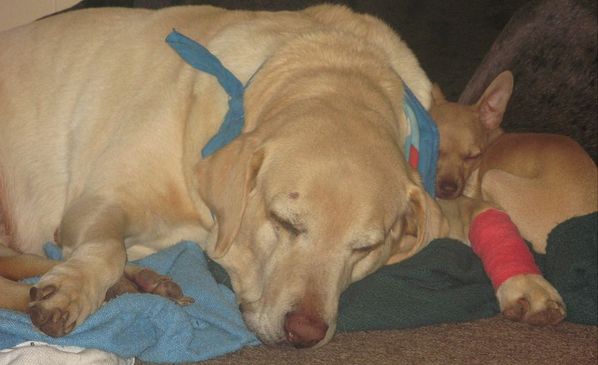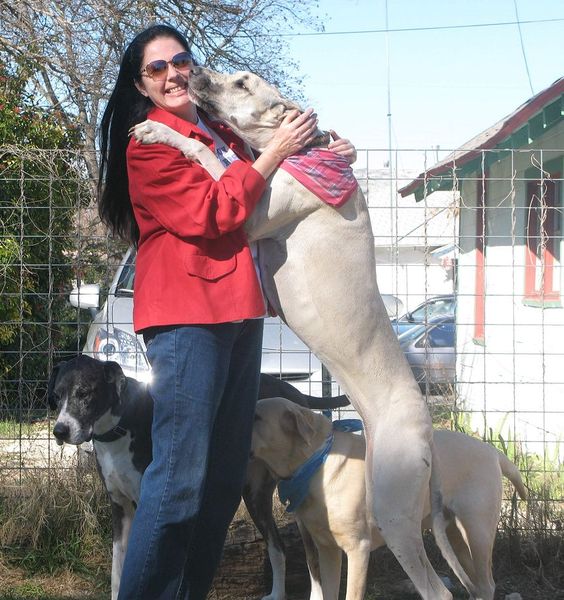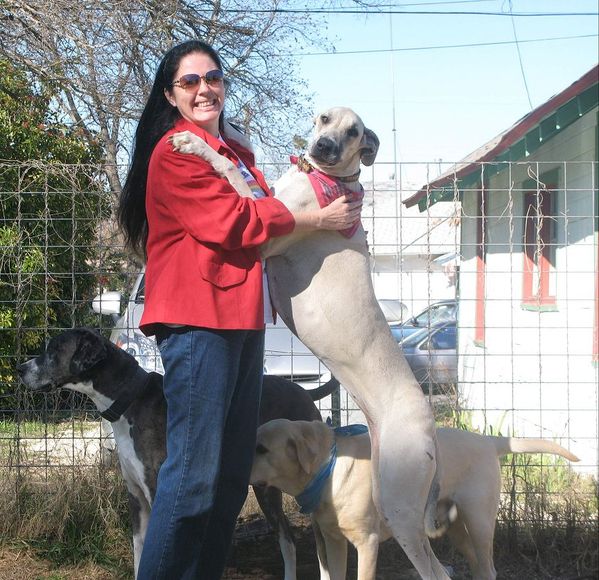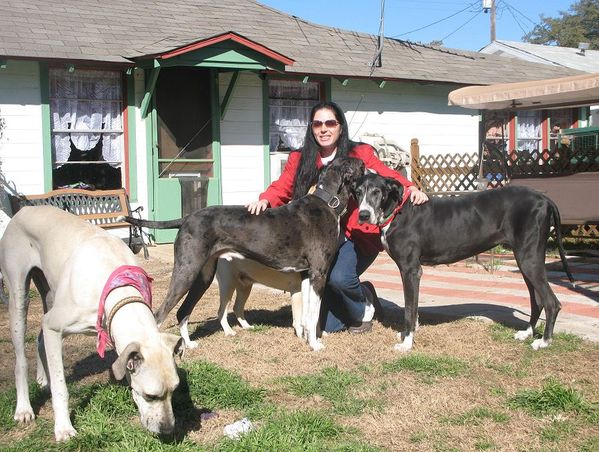Jan 17, 2010
Teachers join the Rainbow Wildlife Rescue
But that's just the tip of the iceberg! 3 teachers from Gilbert Intermediate School in Stephenville have visited the Rainbow Wildlife Rescue and want to become actively involved ranging from joining the board of directors to assisting in fundraising, receiving basic wildlife care training, and most importantly develop educational programs to get the kids involved. This would make one of my lifelong dreams come true! Stay tuned for the introductions.
The highlight of our educational program will be web cams in the enclosures streaming live pictures of the animals into the classrooms. The kids can observe these animals throughout the day and collect data on them. This would align with the state Science TEKS particularly with 5th grade and below.
Usually these animals are seen dead on the side of the road but students rarely observe them alive, watching them eat or learning where the sleep. The benefit of having the kids watch the webcam in class would hopefully show them how much amazing wildlife is in their own area.
The students taking the TAKS test will be asked some questions relating to their state and the animals/plants that grow here. If they have never been able to observe an animal in it's habitat it's hard for them to relate.
In order to achieve this goal we are in need of 4 outdoor webcams or security cams that can operate wireless and on batteries and are capable of streaming video over the internet. In addition we need a laptop or netbook to record the pictures and transport data and presentations to schools and other educational demonstrations.
If you would like to help us out in any way, please click HERE!
Thank you in advance.
Jan 15, 2010
Top Most Common Pet Poisons of 2009
Is your pooch mad for people food? Does your kitty like to self-medicate? Sadly, not everything we love is good for us. In fact, many common household goods that we take for granted as harmless can poison our furry friends. In 2009, the ASPCA Animal Poison Control Center in Urbana, IL, handled more than 140,000 cases of pets exposed to toxic household substances, including insecticides, cleaning supplies and prescription medications.
To help you keep your pet safe and sound in 2010, our experts have created a list of the 10 common poisons that most affected our furry friends last year. Here’s a sneak peek at their advice:
- Top dishonors—once again—go to human medications, which accounted for the most calls to the ASPCA’s 24-hour poison control hotline in 2009. Pets often snatch pill vials from counters and nightstands or gobble up meds accidentally dropped on the floor. Remember to keep all medications, including pain remedies, antidepressants and decongestants, in a cabinet far away from pets’ prying paws.
- Cats and dogs are often the unwitting victims of our efforts to battle flea infestations. The misapplication of spot-on flea and tick products can be especially problematic for our feline friends. Talk to your vet about choosing the right, species-specific flea treatment for your pet and never use products made for dogs on cats, and vice versa.
- Some of the most delicious people food—including citrus, avocado and raisins—can be poisonous to pets. Chocolate ingestion accounted for nearly half of all people food-related cases in 2009, so be sure to keep cocoa hidden from your resourceful cat or dog.
- Pet parents also need to remember to protect their cats and dogs from common household cleaners such as bleaches, detergents and disinfectants. These products, when inhaled by our furry friends, can cause serious gastrointestinal distress and irritation to the respiratory tract.
- Household plants may keep your house green and your air clean, but some can cause serious gastrointestinal problems for companion animals who nibble on them. Check out our toxic plant list before your next visit to the nursery.
As always, if you suspect your pet has ingested something toxic, please call your vet or the ASPCA’s 24-hour hotline at (888) 426-4435. To read our complete list of the 10 most common pet poisons of 2009, visit APCC online.
How to rehabilitate a scared Puppy

1. Do not ever pity a dog. Most dog owners make the mistake and apply human psychology to a dog by talking to them in a high pitched baby voice and offering affection or treats in the attempt to provide comfort to the fearful canine. This only reinforces the fear and teaches the dog that it's ok to be scared. He even gets rewarded for it with affection and treats. That's obviously not the message we want the dog to get.
2. Do not feed into the fearful behavior, ignore it. Instead wait for him to show the slightest hint of courage and brave behavior, then praise him.
3. Provide the dog with as much socialization and exposure to new things as you can, always in a calm and assertive manner.

4. You've probably heard it from the Dog Whisperer Cesar Milan before: No Touch, No Talk, No Eye Contact.
Make sure your guests understand that they need to completely ignore the dog until he makes contact on his own, usually by sniffing. Even then they need to avoid eye contact, do not bend over the dog which appears as a threat to most canines, and pet the dog under the chin and chest instead of the top of the head. This is the hardest part of all..getting humans to understand that they do not do the dog a favor by feeling sorry for him and forcing their affection on them.
5. The power of the pack works every time because learning from other dogs that are balanced is much more effective than any human effort could accomplish.



Jan 12, 2010
Doogle, Chihuahua, abused, neglected, mistreated, rescued
Doogle was kept in a small round bird cage hanging off the ceiling in a run down puppy mill and then dumped over the animal shelter's fence in the middle of the night about a year ago. He couldn't even walk.
Had no clue how. After his rehabilitation, which took 2 surgeries and a lot leadership to give this little 3 lbs guy some confidence, he has come around nicely and lives with 2 Great Danes and a Labrador at the Rainbow Wildlife Rescue in Texas, his forever home. We are considering teaching him some more tricks and taking him to schools to teach kids how to take proper care of their own pets. GO DOOGLE DUCK GO!
Jan 11, 2010
Items needed for Education and Schools
One of the highlights in this program will be outdoor cams transmitting pictures of the animals in our care live into the classrooms.
But for that we need the cams and a laptop computer.
Here is a list of top priority items we need:
- A laptop or netbook computer for educational, administrative and presentation purposes.
- 4 wireless battery-powered outdoor webcams for the enclosures to be transmitted straight into classrooms.
- Fencing Material (lattice, privacy panels, chain link, fence posts and poles, concrete)
- Green House Frame for a flight cage for songbirds (minimum size 6' width, 8' length, 8' height)
- Pick-up Truck or Van for Animal Transport and Rescue Missions
All our sponsors will be featured on our Sponsor page!
Further we have planned to pick up some of the over 26000 animals that have been seized in Arlington, TX from US Globals Exotics. While it is not determined what kind of animals we'll be bringing home or even when exactly, the purpose of them will be educational as described above.
That also means we have to build more habitats and fences to keep these animals secure. Any help with items, funds or if you are handy, your time helping us build it all, will be much appreciated!
Jan 10, 2010
Laila was adopted!

Jan 7, 2010
26,411 Exotics seized
http://www.spca.org/site/News2?page=...iv _ctrl=1481
http://ow.ly/T3Tg
City of Arlington Awarded Custody of 26,411 Reptiles, Insects, Arachnids, Crustaceans and Mammals
Wednesday, January 6, 2010
By: Jaklin Kaden
(DALLAS, TX); January 6, 2009--The City of Arlington was awarded custody of 26,411 animals--reptiles, insects, arachnids, crustaceans and mammals--seized from U.S. Global Exotics on Tuesday, December 15 under the authority of Arlington Animal Services at a hearing at the Arlington Municipal Courthouse.
Click here to download the ruling.
"The Respondents (Jasen and Vanessa Shaw) cruelly treated all of the animals made subject of this hearing by cruelly confining the animals. In particular, all of the animals were cruelly treated in one of more of the following manners: cruelly confined and injured due to such confinement; unreasonably denied necessary food and water, subjected for an extended period of time to food and/or water contaminated with foreign substances including but not limited to feces and urine…and denied necessary veterinary care," said Judge Michael Smith.
"Given that thousands of animals were clinically/subclinically sick on seizure, many will continue to suffer morbidity and mortality due to Global's abuse; veterinary treatment and other expert care can do only so much. My understanding is that Global was losing/throwing in the dumpster 500 animals--not all quite dead at the time--a day (which fits with the finding of 600 animals discovered sick/dead at the facility on the day of the seizure), and that makes 3,500 animals a week; we've certainly reduced that figure. Approximately 80% of Global’s animals were identified (by independent veterinary and other assessment) as sick and dying at seizure; whereas now approximately 80% (due to our care) are out of danger/healthy. Many of the 4,000 'listed dead since seizure' were necessarily euthanased on humane grounds; many showed truly pitiful suffering from starvation, dehydration, gross infectious disease including devastating radiating sores, partially cannibalised yet still living bodies, and many others in unsavable condition," said Dr. Clifford Warwick, one of the scientific specialists brought in to assist with the animal seizure, aftercare and testimony in court.
This case sheds light on a very dark industry that sells pets commonly sold at pet stores. Purchasers are often not aware of the horrific conditions in which these animals live. This industry is regulated, but that regulation has not prevented the suffering. Better enforcement of existing laws and regulations is critical to preventing animals from suffering this kind of abuse.
None of the animals will be available for adoption. The SPCA of Texas will place the animals with reputable organizations such as zoos and sanctuaries to ensure they do not go back into the pet trade business or are not released into the wild.
Four days before seizure, Arlington Animal Services asked the SPCA of Texas and the Humane Society of North Texas to assist with the transport and housing of these animals. This multi-agency partnership between the Arlington Animal Services, the SPCA of Texas and the Humane Society of North Texas was critical to ensuring the care of these animals until the final ruling made at the custody hearing.
Species-appropriate experts arrived from all over the world to direct the care of these animals that were seized in what is being called the largest animal rescue of exotic animals in a cruelty case ever in the United States. These experts were on hand during the seizure and while the animals are being housed.
The animals were removed from a business that specialized in shipping them to pet trade businesses globally. Hundreds of the animals were found dead, and thousands more were acutely suffering from severely overcrowded conditions, cruel confinement, lack of food and water and lack of appropriate care.
A pervasive smell of death permeated the U.S. Global’s building where the animals had been housed. Some animals, including Iguanas and turtles, had been left in packing crates without food, water or appropriate living conditions for unknown periods of time, possibly weeks. Other animals had begun to cannibalize each other, possibly due to severely overcrowded conditions and utter lack of food. Many animals may have been crushed to death by the weight of the hundreds of other animals piled on top of them in certain enclosures. In some cases, hundreds or even thousands of animals were forced to live in containers together to fight for what little food and water was available. Snakes and other reptiles were housed in areas that were far too cold while other animals were kept in individual containers so tiny that they could not move.
This massive effort has required a tremendous amount of effort, time and expense. The SPCA of Texas would like to thank the City of Arlington, the Humane Society of North Texas and the veterinarians and experts from around the world for their tremendous efforts on behalf of these animals.
"The sheer volume of animals in this seizure was unlike anything I've seen before in more than 30 years working in the animal welfare field," said James Bias, President of the SPCA of Texas. "Without the partnership between these groups, these animals would still be living in the horrific conditions they were removed from, and the loving care of the veterinarians and experts was critical to the animals' well-being."
To help the SPCA of Texas fund future rescues like this and to support the SPCA of Texas' other programs and services, please visit www.spca.org/helptheanimals. To learn more about the SPCA of Texas, please visit our website at www.spca.org.
Jan 5, 2010
How to make a Donation to the Rainbow Wildlife Rescue
| Donate using Paypal | Donate using |

Please select an amount: | OR  |
| Mail Check or Money Order to: | Order and/or send Items directly to: |
Rainbow Wildlife Rescue
| |
| Become a Member (coming soon) | Sponsor an Animal (coming soon) |
| Honor Giving (coming soon) | Buy Wildlife Merchandise (coming soon) |
| Pixel Fundraiser (coming soon) | Raffle (coming soon) |
|
|
|
| The Rainbow Wildlife Rescue is a 501(c)(3) non-profit charitable organization. All donations are tax deductible! For more information please call (254) 968-4626 or email me (Birgit Sommer) at help@rainbowwildlife.com. | |
How much does it all cost???
A LOT! The Rainbow Wildlife Rescue went through over 50 lbs of Esbilac and KMR milk replacers in 2009, that's close to $3000 alone.
We spent a lot more on medical supplies, bottles, cleaning supplies, caging, bedding, canned food, dried feed, meat and fresh produce, live food, repairs, maintenance, and not to forget the utility bills that are 3 times as high than average when the rescue is full and the phone bill, which also triples during baby season.
About 30% of the cost were covered by donations and online fundraisers. A HUGE THANK YOU to everybody that had the heart and means to support our efforts!
The remaining 70% I earned with online jobs such as web design and hosting, site maintenance, translations, article writing, graphic design, etc.
Even though I enjoy these jobs, I'd wish I could spend that time focusing on the animals and education instead of earning the money for feeding them. This is where I need your help.
The following points are a few examples of how your donation can help:
- $1000 helps with the utilities and phone bill for 3 months
- $ 500 pays for raising and vaccinating an 2 infant raccoons
- $ 250 will feed a litter of opossums from infant to release
- $ 100 will provide infant formula for 3 squirrels
- $ 50 provides bird food from nestling to adult
- $ 40 pays for a 30 lbs bag of Premium dog food
- $ 20 covers the de-wormer to fight internal parasites in 1 raccoon
- $ 10 provides fresh produce for most critters for 2 days
Top Priority Items:
- A laptop or netbook computer for educational, administrative and presentation purposes.
- Fencing Material (lattice, privacy panels, chain link, fence posts and poles, concrete)
- Green House Frame for a flight cage for songbirds (minimum size 6' width, 8' length, 8' height)
- Incubators
- Petfood and Catlitter (KMR and Esbilac Milkreplacers, Premium dog/puppy and cat/kitten food, dry and cans. Premium means that the top 3 ingredients on the label MUST contain real meat, not by-products, e.g. IAMS ProActive has real chicken as first ingredient.)
Also needed:
- Committed Volunteers, including Rehabbers & Veterinarians
- Release sites in Erath County
- 4 or 5 ft tall ferret type cages with 1/2 to 1 inch gaps
- Small and large bird cages
- Hamster cages
- Guinea pig cages
- Fish tanks with lids
- Terrariums
- Infant medical supplies
- Wild bird and sunflower seed
- Nuts, Pecans
- Pedialyte
- Storage bins with lids
- Paper towels, large trash bags, zip lock freezer bags, laundry detergent, bleach
Medical Supplies (for the Vets):
- Incubators
- Infant Amoxil
- Clavamox
- Pedialyte
- Lactated ringers
- Bene-Bac
- De-womers (Drontal, Strongid)
- Topical eye antibiotic cremes
- Wound care supplies
- Frontline, Advantage, Advantix etc
- Capstar
- Syringes with tiny needles
- Tiny feeding tubes
- IV tubes
- Pain meds
- Calming meds
- De-congestant
- Vaccinations (feline and canine)
- Anti fungal meds (oral and topical)
- Burn treatment
Happy New Year 2010 and Thank You
 | |||
| |||
| My name is Birgit Sommer. I am a licensed wildlife rehabilitator for the State of Texas, managing director of the Rainbow Wildlife Rescue in Stephenville, TX , as well as the vice president and foster parent for the Erath County Humane Society. | |||
We have raised $600 out of the $5000 that is needed before the start of the 2010 orphaned baby animal season, which will begin usually around mid February. Thank you soooo much!!!! During these economically tough times I realize that there is not much money left to donate to charity, so let me share with you some items the Rainbow Wildlife Rescue needs that you might have and don't need anymore: The top 5 most needed times are (extended wish list below):
| |||
I, like many other licensed wildlife rehabilitators, work out of my own home and volunteer my time and just about every spare cent I can gather towards animal rescue efforts and public education. No local or state funding is available for animal caging, veterinary care, medicine and food. That's why most rehabilitators gratefully accept donations towards the care of animals they receive from the public. |  | ||
The following are a few examples of how your donation can help:
Paypal Email to use: webmaster@rainbowwildlife.com  Support the Rainbow Wildlife Rescue Rainbow Wildlife Rescue Ark Veterinary Hospital
| |||
Don't Buy, Adopt a Pet!Whether you adopt a pet from a local animal shelter, rescue organization, or human society, it doesn't matter because you're saving lives! You probably want to adopt just one kitten or cat, right? Adoption saves more than just the life of the pet you adopt. If you adopt from an animal shelter, you're making room for another dog or cat, or you're allowing other dogs or cats at the shelter to be kept for a longer period of time, giving them a better chance at being adopted. If you adopt from a humane society or a rescue organization, you're allowing that organization to rescue another dog or cat for adoption at a public shelter, which, of course, saves the life of that little guy plus the lives of others at that shelter by creating space so new pets can be kept longer. As you can see, adoption is truly a continuous cycle of saving lives and it's the right thing to do! | |||
Birgit Sommer's Websites:Critter Blog with regular Updates - Kittenbaby.com - Puppy Education - Funny Animal E-Cards - Squirrel Rescue Texas - Rainbow Wildlife Rescue in Texas - Pets and Wildlife Forum - Magic Postcards - MissDolittle on YouTube - Stephenville Dog Park - Webdesign in Support of the Rescue | |||
Jan 4, 2010
Reina has been adopted plus 4 Golden Dog Rules
I am missing her already and my other dogs had a whining fit last night too...she sure made an impression on us all in that just one week we had the pleasure of living with her.
Let me take the opportunity to share the 4 golden rules I live by in order to keep my dogs under control and balanced. Of course everything is based on the Dog Whisperer Cesar Milan's teachings:
- Avoid getting the dog excited (no high pitched human baby voices or giving rewards while excited)
- Stay calm and assertive (never yell or scream or get frustrated at a dog, it's simply not necessary)
- Nothing is free (dog has to sit for affection, follow me on a walk in order to get food, do tricks for a treat etc)
- Rules, boundaries and limitations before food and affection. Always.







